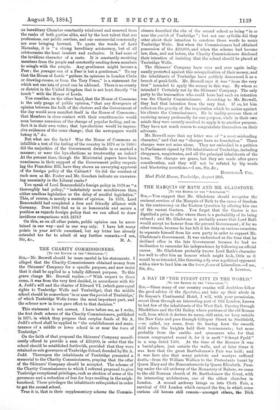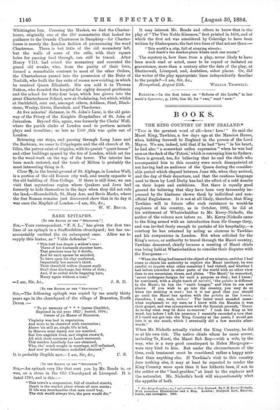A DAY IN "THE FINEST CITY IN THE WORLD."
[To THE EDITOR OF THE " SPECTATOR."1 SIR,—Since many of our country cousins will doubtless follow the good advice of the Spectator, and take up their abode in De Keyser's Continental Hotel, I will, with your permission, escort them through an interesting part of Old London, known to but few of the inhabitants of the West End. Passing through Blackfriars and the Old Bailey, where portions of the old Roman wall, from which it derives its name, still exist, we keep outside the New Gate and pass through Giltspur Street to Smithfield, —so called, say some, from its having been the smooth field where the knights held their tournaments ; but more probably from the smiths and armourers who for that reason congregated round it, for it is spelt " Sehmyt Fyeld " in a map dated 1560. At the time of the Romans it was a burial-place, just outside the walls, and at later times it was here that the great Bartholomew's Fair was held ; and it was here also that many patriots and martyrs suffered death,—from Sir William Wallace to the Protestants burnt by Queen Mary and the Nonconformists by Queen Elizabeth. Pass- ing under the old archway of the Monastery of Rahere, we come to the old Norman church of St. Bartholomew the Great, with its interesting architecture, one of the oldest churches in London. A second archway brings us into Cloth Fair, a survival of Old London which escaped the fire, in which some curious old houses still remain—amongst others, the Dick
Whittington Inn. Crossing the Market, we find the Charter- house, originally one of the 210 monasteries that looked for guidance to the Grande Chartreuse in Dauphiny—for Charter- house is merely the London fashion of pronouncing the word Chartreuse. There is but little of the old monastery left, but the walls of some of the cells, with their square holes for passing food through, can still be traced. After Henry VIII. had seized the monastery and executed the grand old monks, who, hour the purity of their lives, formed a remarkable contrast to most of the other Orders, the Charterhouse passed into the possession of the Duke of Norfolk, who built the fine suite of rooms now existing, in which he received Queen Elizabeth. His son sold it to Thomas Sutton, who founded the hospital for eighty decayed gentlemen and the school for forty-four boys, which has grown into the great Charterhouse School, now at Godalming, but which, whilst at Smithfield, sent out, amongst others, Addison, Steel, Black- stone, Wesley, Grote, Havelock, and Thackeray.
At five minutes' distance, in St. John's Lane, is the old gate- way of the Priory of the Knights Hospitallers of St. John of Jerusalem. Beyond this, again, was formerly the Clerks' Well, where the parish clerks of London used to perform miracle plays and moralties ; as late as 1560 this was quite out of London.
Retracing our steps, and passing through Long Lane and the Barbican, we come to Cripplegate and the old church of St. Giles, the patron saint of cripples, with its quaint "quest-house" and other buildings spared by the fire of London, which set fire to the wood-work on the top of the tower. The interior has been much restored, and the tomb of Milton is probably the most interesting thing in it.
Close lfy, in the burial-ground of St. Alphage, in London Wall, is a portion of the old Roman city wall, and nearly opposite is the old building of Zion College. If there is still time, we can visit that mysterious region where Quakers and Jews had formerly to hide themselves in the days when they did not rule the land,—Houndsditch, St. Mary Axe, and Bevis Marks, where the fine Roman remains just discovered show that in its day it was once the Mayfair of London.—I am, Sir, &c., W. W. Baum



































 Previous page
Previous page